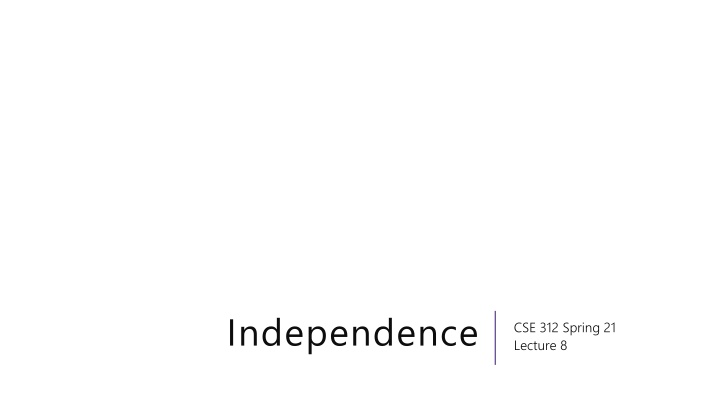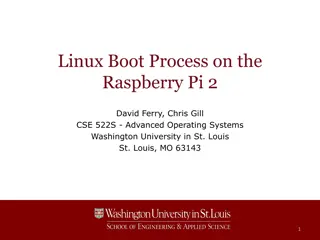Raspberry Pi in July: Getting it Working and Doing Stuff!
The specifications of Raspberry Pi models, hardware requirements for setting up a monitor and input devices, software installation steps including Raspbian configuration, Python programming for beginners, and interfacing with external devices like DDS (AD9850). Get your Raspberry Pi up and running for a variety of projects this July!
Download Presentation

Please find below an Image/Link to download the presentation.
The content on the website is provided AS IS for your information and personal use only. It may not be sold, licensed, or shared on other websites without obtaining consent from the author.If you encounter any issues during the download, it is possible that the publisher has removed the file from their server.
You are allowed to download the files provided on this website for personal or commercial use, subject to the condition that they are used lawfully. All files are the property of their respective owners.
The content on the website is provided AS IS for your information and personal use only. It may not be sold, licensed, or shared on other websites without obtaining consent from the author.
E N D
Presentation Transcript
Independence CSE 312 Spring 21 Lecture 8
Announcements HW2 due tonight HW3 out this evening. HW3 includes a programming project using Bayes rule to do some machine learning detecting whether emails are spam or ham (legitimate emails). Longer than the programming on HW1 please get started early! Extra resources with common difficulties on the programming project will be linked in the HW3 pdf.
Today Outline: Independence Chain Rule Conditional Independence
Definition of Independence We ve calculated conditional probabilities. Sometimes conditioning getting some partial information about the outcome doesn t actually change the probability. We already saw an example like this
Conditioning Practice Red die 6 conditioned on sum 7 1/6 Red die 6 conditioned on sum 9 1/4 Sum 7 conditioned on red die 6 1/6 D2=1 D2=2 D2=3 D2=4 D2=5 D2=6 (1,1) (1,2) (1,3) (2,1) (2,2) (2,3) (3,1) (3,2) (3,3) (4,1) (4,2) (4,3) (5,1) (5,2) (5,3) (6,1) (6,2) (6,3) D1=1 D1=2 D1=3 D1=4 D1=5 D1=6 (1,4) (2,4) (3,4) (4,4) (5,4) (6,4) (1,5) (2,5) (3,5) (4,5) (5,5) (6,5) (1.6) (2,6) (3,6) (4,6) (5,6) (6,6) Red die 6 has probability 1/6 before or after conditioning on sum 7.
Independence Independence Two events ?,? are independent if ? ? = ? (?) You ll sometimes see this called statistical independence to emphasize that we re talking about probabilities (not, say, physical interactions). If ?,? both have non-zero probability then ? ? = (?) (?) ? ? = (?) ? ? = (?)
Examples We flip a fair coin three times. Each flip is independent. (both in the statistical independence sense and in the doesn t affect the next one sense). Is ? = {???} independent of ? = at most two heads ? Are ? = the first flip is heads and ? = the second flip is tails independent?
Examples Is ? = {???} independent of ? = at most two heads ? ? ? = 0(can t have all three heads and at most two heads). ? = 1/8, ? = 7/8, ? ? = ? (?). Are ? = the first flip is heads and ? = the second flip is tails independent? ? ? = 2/8 (uniform measure, and two of eight outcomes meet both ? and ?. ? = 1/2, ? = 1/22 8=1 2 1 2. These are independent!
Hey Wait I said the flips are independent why aren t ?,? independent? the flips are independent means any event <the first flip is blah> is independent of <the second flip is blah> But if you have an event that involves both flip one and two that might not be independent of an event involving flip one or two.
Mutual Exclusion and independence Two of these statements are true, one is false. Explain to each other which ones are true, and find a counter-example to the false one. 1. If ?,? both have nonzero probability and they are mutually exclusive, then they cannot be independent. 2. If ? has zero probability, then ?,? are independent (for any ?). 3. If two events are independent, then at least one has nonzero probability. Fill out the poll everywhere so Robbie knows how long to explain Go to pollev.com/cse312
Mutual Exclusion and independence Two of these statements are true, one is false. Explain to each other which ones are true, and find a counter-example to the false one. 1. If ?,? both have nonzero probability and they are mutually exclusive, then they cannot be independent. 2. If ? has zero probability, then ?,? are independent (for any ?). 3. If two events are independent, then at least one has nonzero probability.
Chain Rule We defined conditional probability as: ? ? = ? ? ? Which means ? ? = (?|?) (?) Chain Rule ?1 ?2 ?? = ???1 ?? 1 ?? 1?1 ?? 2 ?2?1 (?1)
Chain Rule Example Shuffle a standard deck of 52 cards (so every ordering is equally likely). Let ? be the event The top card is a K Let ? be the event the second card is a J Let ? be the event the third card is a 5 What is (? ? ?)? Use the chain rule! ? ? ? (?|? ?) 1 52 1 51 1 50
Conditional Independence We say ? and ? are conditionally independent on ? if ? ? ? = ? ? (?|?) i.e. if you condition on ?, they are independent.
Conditional Independence Example You have two coins. Coin ? is fair, coin ? comes up heads with probability 0.85. You will roll a (fair) die, if the result is odd flip coin ? twice (independently); if the result is even flip coin ? twice (independently) Let ?1be the event the first flip is heads , ?2be the event the second flip is heads , ?be the event the die was odd Are ?1 and ?2 independent? Are they independent conditioned on ??
(Unconditioned) Independence ?1 = ? ?1? + ? (?1| ?) =1 2 0.85 = .675 ?2 = .675 (the same formula works) ?1 ?2 =.6752= .455625 ?1 ?2 = ? ?1 ?2? + ? (?1 ?2| ?) =1 Those aren t the same! They re not independent! Intuition: seeing a head gives you information information that it s more likely you got the biased coin and so the next head is more likely. 2 1 2+1 2 1 4+1 2 .852= .48625
Conditional Independence ?1? = 1/2 ?2? = 1/2 ?1 ?2? =1 2 1 2= 1/4 ?1? ?2? = (?1 ?2|?) Yes! ?1 and ?2 are conditionally independent, conditioned on ?.
Takeaway Read a problem carefully when we say these steps are independent of each other about some part of a sequential process, it s usually conditioned on all prior steps, these steps are conditionally independent of each other. Those conditional steps are usually dependent (without conditioning) because they might give you information about which branch you took.
Implicitly defining We ve often skipped an explicit definition of . Often | | is infinite, so we really couldn t write it out (even in principle). How would that happen? Flip a fair coin (independently each time) until you see your first tails. what is the probability that you see at least 3 heads?
An infinite process. is infinite. A sequential process is also going to be infinite But the tree is self-similar From every node, the children look identical (H with probability , continue pattern; T to a leaf with probability ) ? =1 ? =1 2 2 H ? = 1/2 ??|? =1 ??|? =1 2 2 H ?? = 1/4 ???|?? =1 ???|?? =1 2 2 H ??? = 1/8
Finding (at least 3 heads) Method 1: infinite sum. includes ??? for every ?. Every such outcome has probability 1/2?+1 What outcomes are in our event? 1 1 1/2=1 24 1/2?+1= ?=3 Infinite geometric series, where common ratio is between 1 and 1 has closed form first term 1 ratio 8
Finding (at least 3 heads) Method 2: Calculate the complement (at most 2 heads) = 1 2+1 4+1 8 1 2+1 4+1 =1 (at least 3 heads)= 1 8 8

















